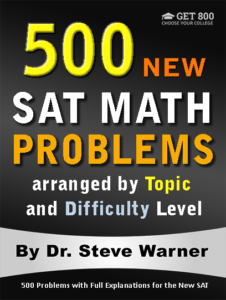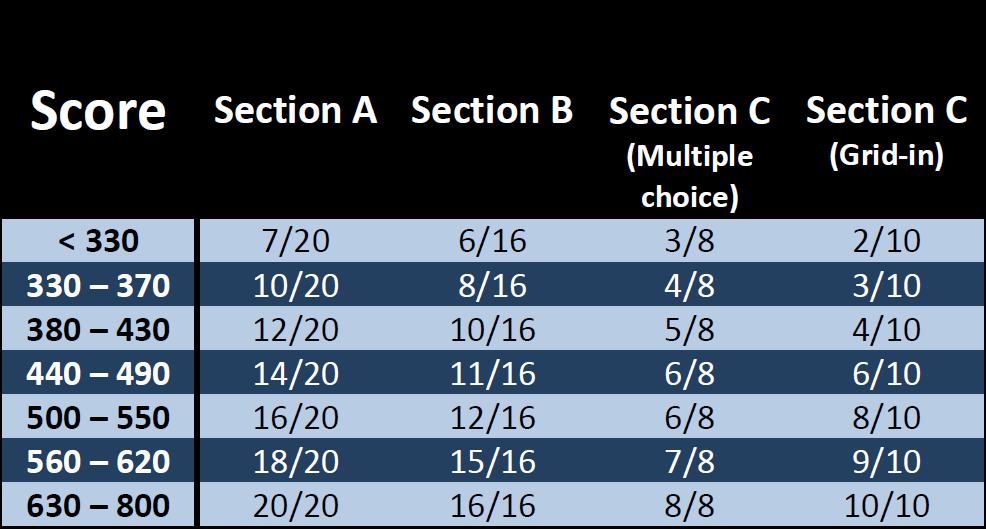
500 New SAT Math Problems
Just 19.99 on Amazon
Hi everyone! The latest edition of 500 New SAT Math Problems is now available in paperback from Amazon. This edition just has been modified from the previous edition to account for the changes on the Digital SAT.
The paperback is now on sale on Amazon for only $19.99. Note that once the sale ends (by the end of today), the price of this book will go up to $42.99.
The promotion has ended. Thanks to everyone who participated. The book is now available at its regular price here: 500 New SAT Math Problems
If you have any questions, feel free to contact me at steve@SATPrepGet800.com
Thank you all for your continued support!
A Trick For Free Two Day Shipping
I would like to finish this post with a little trick you can use to get free 2 day shipping on any of the books you decide to purchase without making any additional purchases. If you have never used Amazon Prime you can sign up for a free month using the following link.
Sign Up For Amazon Prime For Free
If you have already had a free trial of Amazon Prime you can simply open up a new Amazon account to get a new free trial. It just takes a few minutes! You will need to use a different email address than the one you usually use.
This next part is very important! After you finish your transaction, go to your Account, select “Manage my prime membership,” and turn off the recurring billing. This way in a month’s time Amazon will not start charging you for the service.
After shutting off the recurring billing you will still continue to receive the benefit of free 2 day shipping for one month. This means that as long as you use this new Amazon account for your purchases you can do all of your shopping on Amazon for the next month without having to worry about placing minimum orders to get free shipping.
Just be aware that certain products from outside sellers do not always qualify for free shipping, so please always check over your bill carefully before you check out.
Well I hope you decide to take advantage of this very special offer, or at the very least I hope you will benefit from my Amazon “free 2 day shipping trick.” Here is the link one more time:
Sign Up For Amazon Prime For Free
If you think your friends might be interested in this special offer, please share it with them on Facebook:
Thank you all for your continued support!
I am in the process of creating a free SAT math iPhone app.
I was researching technical details on fine tuning this app and came across this article on other useful SAT apps at Student Advisor.
I know that the summer vacation is almost over, but your SAT prep probably is not. So despite the title, these apps can be used throughout the year!
Lately I have been including posts that give advice on applying to colleges. First, of course, you need to know to which colleges you would like to apply.
Picking the ideal college is never easy – there are so many considerations that can sway your decision.
I found the linked post on picking a college at The College Solution. Be sure to take a look at the links on the article as there is even more information on this particular topic within them.
Continuing our theme on application requirements, I have included this link from College Admissions Partners on what is required above grades, SAT scores, GPAs, etc…
On the Get 800 Facebook page I was asked a question about the SAT scores that are expected by the top colleges. This is an excellent question that I’m certain many students would like the answer to.
I found this page at About.com that answers this question and I think that this information is important enough to share with all of you.
I found this article from Powerscore explaining Grade Point Averages.
I thought this was worth sharing because students often ask if their GPAs are good enough to get into certain colleges. Of course, there is more to a successful college application than just a GPA score: for example, the SAT score is another factor!
I found this webpage on the About.com website.
Students often worry about sending their best SAT score to the college that they want to apply to. Read the information in the link to determine if Score Choice is the best option for you.

1. Answering too many questions.
Students have been trained since they were very young that they not leave any questions blank on tests. For most in-class exams this is good advice. On standardized tests however this advice is terrible. Attempting to answer too many questions on the SAT is guaranteed to lower your score. Here are some of the negative effects of answering too many questions:
- Precious time is wasted attempting problems that are too hard. This time could be spent ensuring easier problems are correct.
- Students lose points by attempting hard problems, getting tricked and getting them wrong. This costs a quarter of a point per hard question.
- Students spend less time on easier problems, thus making careless errors. This would be considered a 1.25 point loss per question: 1 point for not getting the question correct, and .25 for getting the question wrong.
- Test taking anxiety is much higher because the student has too many questions to get to in very little time. This leads to more careless errors.
In many cases simply by reducing the number of questions that you answer on the exam your score can go up 40 points or more. This may seem unlikely but if you think about it for a moment it makes perfect sense. If you eliminate just one careless error per math section, you add 1.25 points to your raw score per section (1 point for getting the question right, and .25 for not getting the question wrong). That’s a total of 3*1.25 = 3.75 points which rounds up to 4 points. This translates roughly to 40 points on the SAT.
So how many questions should you be answering? There is no absolute answer to this, but here is a general guideline. There are 3 math sections on the SAT. They can appear in any order. There is a 20 question multiple choice section, a 16 question multiple choice section, and an 18 question section that has 8 multiple choice questions and 10 grid-ins.
Let’s call these sections A, B and C, respectively. You should first make sure that you know what you got on your last SAT practice test, actual SAT or actual PSAT, whichever you took last. What follows is a general goal you should go for when taking the exam.

This is just a general guideline. Of course it can be fine tuned. As a simple example, if you are particularly strong at number theory problems, but very weak at geometry problems, then you may want to try every number theory problem no matter where it appears, and you may want to reduce the number of geometry problems you attempt.
2. Not checking answers.
Many students feel a terrible amount of time pressure when taking their SAT. One of the primary causes of this is answering too many questions, as stated above. Students therefore tend to rush through questions without checking over their work. This results in a significant number of careless errors.
The fact is that if you’re taking the test correctly, there is no need to rush through anything. You should be able to do each problem, and check it over quickly before moving on. Use the strategies that I teach you to get through problems quickly, but don’t rush through the actual mechanics of doing the problem.
Furthermore, you should always use at least five minutes at the end of the test for going back and checking over your earlier work. Remember, if you catch just one careless error per section, your score will go up approximately 40 points.
3. Getting hung up on one question.
Students often have the misconception that if they abandon a problem, all the time that they have put into it has been wasted. Nothing could be further from the truth. In fact, sometimes leaving a problem temporarily is the best thing you can do to solve that problem. I can’t tell you how many times I have abandoned a problem to do something else, and then all of a sudden many minutes later the answer came to me without me even consciously thinking about it.
Even if this doesn’t happen, coming back to a problem later with fresh eyes is often very helpful. Your mind will not forget all the work you have already done on that problem.
So when is it time to move on? After you’ve been working on a question for about 1 minute you should make a decision. If you understand the question and think that you can get the answer in another 30 seconds or so, continue to work on the problem. If you still don’t know how to do the problem or you’re using a strategy that is going to take a long time, mark it off and come back to it later if you have time.
If you have eliminated at least one answer choice, or it is a grid-in feel free to take a guess, but you still want to leave open the possibility of coming back to it later. Remember that every problem is worth the same amount. Don’t sacrifice problems that you may be able to do by getting hung up on a problem that is too hard for you.
Make sure that you are wearing a watch on test day. This will help you with your pacing.
4. Going with the first instinct on hard questions.
A standard piece of test-taking advice is to always go with your first instinct. In general this is good advice, but on standardized tests this advice is terrible.
The problem is that the more difficult SAT questions are specifically designed to trick you. This means that if you go with your first instinct, you are probably falling right into the trap that was laid out for you. On high numbered math questions on the SAT you should actually eliminate a choice if your intuition leads you to that answer too quickly. If you have a proper justification for why that particular answer is correct, then of course you can choose that answer. Otherwise however you should take a guess from the other choices.
5. Performing complicated computations.
It is never necessary to do messy algebra or perform tedious and complicated computations. If you find yourself doing this often, it means that you do not know some basic SAT test-taking strategies.
6. Taking the test without knowing the directions and given geometric formulas by heart.
Although I advise you not to rush through questions, you shouldn’t be wasting your time either. The last thing that you want to be doing during the test is reading the directions. They are always the same. Learn them ahead of time.
A more common mistake than that is walking into the test without knowing the geometric formulas that are given to you on the front of each math section. There aren’t that many. Just memorize them. It is a waste of time to be flipping back and forth.
You should also know the formulas for percent change, converting averages to sums, slope of a line, the slope-intercept equation of a line, and the triangle rule. All of these formulas are reviewed in the book “The 32 Most Effective SAT Math Strategies.”
7. Overusing their calculator.
Sometimes I see students typing away on their calculators without taking any break. What they are usually doing here is wasting time. Your calculator is a tool that is there for you to speed up computations. It is not there to solve the problem for you. If you are taking the test right, you shouldn’t be using your calculator all that much.
That said, make sure that you do use your calculator for arithmetical computations. This is usually quicker than doing computations by hand or in your head, and you’re less likely to make a careless error.
Finally, make sure that you know how to input things into your calculator correctly. Many students mess up their order of operations when using calculators, especially using parentheses correctly.
Remember that as a general rule numerators, denominators and exponents should all be in parentheses when using your calculator.
8. Rounding or truncating decimals too soon on gridins.
When gridding in an answer all four slots must be used unless the answer terminates before this. I see students get answers wrong all the time because they rounded an answer to soon. If your calculator displays 2.111111111 for the final answer, then your answer will be marked wrong if you grid in 2.1. You must grid in 2.11.
9. Being nervous for no reason.
Some students get test-taking anxiety, and some more than others. This is just a fact we have to deal with. There are many techniques you can use to alleviate test-taking anxiety such as meditation and other techniques of the mind.
There are some reasons for nervousness that can easily be avoided. For example, reducing the number of questions that you expect yourself to answer can go a long way in making you less nervous. When you come to a problem that is giving you a lot of trouble simply move on to the next one. You don’t need to answer all of them.
Another way to battle nervousness is through confidence. Spend at least 3 months before the exam preparing about 10 to 20 minutes each day. Learn all of the basic strategies that I teach, and make sure to practice some problems that are right at your ability level.
Although getting answers correct does not improve your score (only learning from your mistakes improves your score), getting some answers correct will instill confidence. This will ensure that you don’t decrease your score.
10. Running out of steam.
The SAT is a long test. It’s 3 hours and 45 minutes. Many students lose too much endurance and start performing poorly towards the end of the exam. All you need to do to combat this is to be prepared for it. Try to do at least 2 full practice tests before the actual exam. Struggle through that length of time so you can feel it before it matters.
Be aware that practice tests generally leave out the experimental section. This makes most practice tests a bit shorter than the actual SAT. When I give my students full length practice tests I always add in an extra “experimental” section so that they can really feel the full amount of time. I suggest you do the same. Just take one extra section from another test and add it to your own practice test.
In my book, The 32 Most Effective SAT Math Strategies, I give techniques to solve many types of SAT math problems using nonstandard methods. Some of these techniques are meant to save time, others will prevent careless errors, and most can be used even if one does not have a complete mathematical understanding of the problem.
Strategy 4 from my book is called ‘Pick A Number’ where I suggest that simple numbers are substituted in for a variable to get a solution more easily.
I found this ‘The Ultimate SAT and ACT Math Trick‘ article that describes Strategy 4 in its own words.
I would not call this technique the Ultimate SAT math trick, as there are many other strategies that are equally important, but it does have its place and it can be very useful for solving many SAT math problems.
It is interesting to me to hear the debate on whether the SAT is actually a useful test.
On the one hand I appreciate that colleges/universities want students who have a certain grasp of English and analytical/interpretation (measured by the the critical reasoning and math) skills .
On the other hand, I appreciate that this test can be unfair to many students who would like to go to college but are not academically minded. Not all courses require a high level of analytic ability but many institutions require a relatively high SAT score. I honestly believe there are different ‘types of intelligence’ found among people. Of course, those students without the ideal type of intelligence (from the colleges’ perspective) may miss out on attending college.
I found this article from SAT Exam Savvy and I like what they have to say on this subject.
For the SAT, I always recommend that you use a TI-84 or equivalent calculator to practice with and to use on exam day.
You may want to check out this article for more information about calculator usage and the calculators that you are allowed to use during the SAT and SAT Subject Tests.
